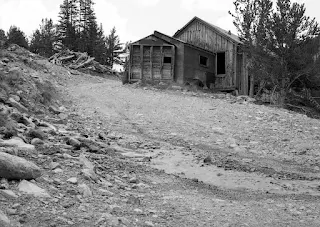 |
| Camera positioned over the D.S.P.& P.Ry. M.P. 155.6. (Romley, CO). Ogden Eating House and both depots to left. Spur tracks to ore bin and rear of 3nd mill to right. 1987 - Poole Photo |
 |
| (Fig.1) R.R. r.o.w. & MMMC road at Murphy, 1881 - Poole Col. |
It was 2.3 miles from St. Elmo to what would become Romley. Of course, there was no Romley in 1881; there was nothing except the road Col. John Kelly, (General Manager of the Mary Murphy Mining Company) built from the mine head to St. Elmo in 1880. The purpose of the road was to transport ore and supplies between the mine and the town and it was one of the first improvements to the property by the new owner.
The mine was discovered near the top of Chrysolite Peak, perhaps as early as 1870. It with other industrial properties were purchased by a St. Louis company for $300k and the Mary Murphy Mining Company (MMMC) was formed to develop the property. The 2.5 mile road that Col. Kelly built started at the mine head, dropped down Pomeroy Gulch until the south bank became so precipitous that the road had to turn south and traverse to the valley floor. There it looped to the north and proceeded to the town. (fig. 1). When the D.S. P.& P. track came through, it crossed the pr-existing road.at Mile Post 155.6 and the railroad designated the station as "Murphy".
 |
| Mary Murphy, Chrysolite Peak, 1983 - Poole Photo |
Over the years, names for M.P.155.6 came and went. Unlike "Murphy", Romley had no district source; spoken, locale, cultural, persona or "otherwise". But even the several interim names tended to be confusing. In a few cases two names appeared on the same page as the same place. Sources and advent of names were often obscured. But, as we may find once available information is sorted out, it will become more clear how the names and town evolved.
 |
| M.P. 155.6; Ogden, MMMC ore bin & mill, June 1882 - Poole Col. |
Right away the railroad installed a switch at M.P. 155.6. This was to service an ore loading bin and perhaps a platform constructed above the grade by the MMMC. There after the railroad renamed M.P.155.6 Murphys Switch. The photo shared below was probably take in June, 1882. Along this spur a coal car was spotted next to the ore bin (for low grade ore). Also the mine's first stamp mill appeared in the background. However, the dense stand of pine below the grade where the town would later be built appeared untouched.
Early in 1882, Fred H. Werlitz, the company Engineer, approached Augustus Helmer, Postmaster of St. Elmo, and request a Post Office for Murphys Switch. In response, Frank Hatton (First Assistant to the Postmaster General in Washington D.C,) sent an application to Werlitz; care of Gus Helmer. Werlitz's promptly filled out the application and returned it to the Department of the Post Office (DPO).
Fred's information on the application supplied substantial insight into the beginnings of what would become Romley. Accordingly, there was "no village" near the station. Mail would be delivered to the mining office (this was within the boarding house from which it is likely the June 1882 photo was taken!). Fred also stated that the population of Murphys Switch was 105 individuals - "and increasing". Of course, most of this population was employees of the mining company but perhaps there were a few attached to the Ogden Eating House.
 |
| MMMC's 1st stamp mill at Murphys Switch, June 1882 - Poole Col. |
The application proposed naming the new Post Office "Neva". The significance of this name is unknown and, fortunately, it is never seen again! The document from Hatton was dated 25 April and Werlitz returned it on 18 May, 1882.
Nothing came of the 1882 application. Nor has an explanation turned up as to why. Presumably the application did not qualify. A reasonable hypothesis might be gathered from information on the application. Perhaps most significant is that there was no town at Murphys Switch. The small population, was almost entirely employed by a private company with no allegiance to stay at the location other than money literally dug out of the rock. Even the applicant was an officers of this objectively dubious operation. From the perspective of the DPO the application simply did not qualify.
 |
| Boarding house at Level 4, 1983 - Poole Photo |
The MMMC had two boarding facilities for employees. The first, as mentioned, was at M.P. 155.6 in the same building as the company office. (See painting in Post 8.) This 2 story structure likely had a dining hall and could house 40 men. The second was at the Level 4 Tunnel about a mile up Pomeroy Gulch from M.P.155.6. This building had a capacity to bunk of 60 men.
As the largest producer in the district, employment at the MMMC was indeed increasing and optimism that would have justification a request for a Post Office is understandable. But transient men living in boarding houses was no measure of a permanent, growing community. It is plausible that the MMMC recognized this as the reason for the apparent denial. Neither is it hard to believe that the company would have translated this setback into determination. So far as we know, there isn't documented to substantiate what seems evident; that they set out to rectify their shortcoming by building their own town. As the stand of pine below the grade began to recede a company town emerged. It was first called Morley after the company President, James H. Morley.











No comments:
Post a Comment